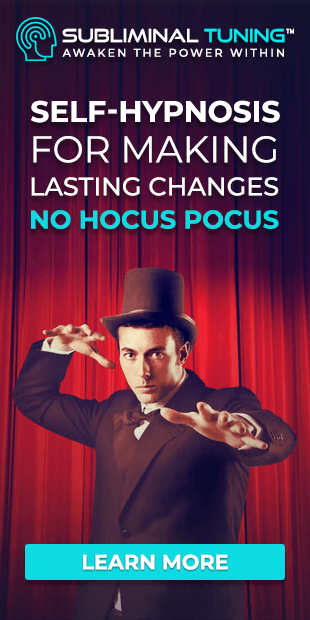Self-hypnosis enables you to enter a state of deep relaxation. In this trance-like state, you become more susceptible to suggestion.
If you have ever found yourself mesmerized or entranced by a roaring fire, ocean waves, or ripples in a lake, you’ve experienced basic self-hypnosis.
What is Hypnosis?
The origin of the word hypnosis is Greek. It comes from the word “hypos,” which means “sleep.” It’s an abbreviation of the term neuro-hypnotism which means sleeping nervous system.
However, hypnosis is not a state of sleep. When you are under hypnosis, you are awake and aware of everything that is happening.
Hypnosis induces a highly focused attention state with heightened suggestibility. When a therapist or a hypnotist induces hypnosis, it is called hetero hypnosis, often referred to as hypnotherapy.
Hypnotic trance-like experiences are quite common. If you’ve ever Spaced out while watching a movie or daydreamed, you’ve been in a similar trance-like state.
Hypnosis is a natural and proven psychological therapy. Medical research continues to show the benefits of hypnosis as a therapy tool.
Perhaps you have seen shows on tv where a hypnotist uses their “hypnotic powers.” These shows aim to make people say and do things that they would not usually say or do under normal circumstances.
If so, it’s hardly surprising that hypnosis could seem a little bit wacky. Hypnosis is primarily a therapeutic tool that can help people overcome psychological, emotional, and even physical problems.

Actual hypnosis, or hypnotherapy in the sense we are discussing, doesn’t involve swaying pocket watches and is not practiced on stage as part of an entertainment act.
How Does Hypnosis Work?
To better understand how hypnosis works, you first need to understand that your mind has two parts, the conscious and the subconscious.
Both parts function simultaneously yet have very different characteristics. Both parts play an important role in the way you live your life.

And you are probably wondering, why a picture of a coconut? Read on.
The Conscious Mind
Your conscious mind is responsible for thinking and analytical functions. It’s the part of the mind you actively use throughout each day.
It is responsible for decision-making, filtering, and categorizing the huge amount of information you process daily.
Your conscious mind can only process and retain a limited amount of information. It simply evaluates your environment and decides what to focus on.
The Subconscious Mind
The subconscious mind is responsible for regulating most of your body’s autonomic functions such as breathing, digestion, and heart rate.
Your subconscious mind also contains huge storage space where every piece of information you ever experience is stored.
The subconscious mind is the source of creativity and your emotions. The subconscious is literal, it does not make judgments, and it cannot determine right from wrong or good from the bad.
It needs the conscious mind to actively evaluate your feelings and emotions. Many activities, once learned, become subconscious, like reading, walking, or driving a car.
Hypnosis Gives Access to the Subconscious Mind
Time to introduce the coconut.

Imagine the shell is your conscious mind, and the flesh and water inside is your subconscious mind.
Your subconscious mind is much bigger than your conscious mind. If there were a conflict between the two, the subconscious would win easily.
When we are fully awake, the conscious mind (shell) completely encloses the subconscious mind (flesh). In essence, the conscious mind is the primary receiver of millions of pieces of data coming to us every second.
Hypnosis relaxes our conscious mind, causing the shell to open. We can then bypass the conscious mind and access the subconscious mind directly.
When you enter a relaxed state, it is easier to access your subconscious mind. However, your conscious mind will still be processing information. Because in hypnosis, you are conscious and fully in control, you are not asleep.
Upon moving into a deeper level of relaxation and entering into a strong hypnotic trance, we can access long-forgotten memories and offer suggestions that may not normally be allowed by the conscious mind.
For example, imagine someone who is a heavy smoker. They are consciously aware that their smoking habit is causing health problems. Still, they cannot give up because smoking for them is a subconsciously programmed behavior.
If we told them, “you do not smoke,” their conscious shell would reject the command.
However, with the mind relaxed and the conscious shell wide open, we would be able to suggest to their subconscious mind that “they do not like smoking and it is harming them.” The subconscious mind would accept this information, and they would stop smoking.
For a more detailed look into the subconscious mind, read our article: The Subconscious Mind.
What is Self Hypnosis?
Self-hypnosis is a form of hypnosis that we can perform by ourselves. Self Hypnosis is simply the act of bringing ourselves into a self-induced hypnotic state of relaxation where we become more susceptible to suggestion.
The most common uses for self-hypnosis are to modify behavior, emotions, and attitudes. Self-hypnosis can reduce anxiety, increase confidence and help you develop new skills. Self-hypnosis can also target specific problems, such as stopping smoking or getting over a fear of heights. Self Hypnosis is also often used by professional athletes to increase physical and mental performance.
Once you have practiced self-hypnosis for a while and know the feeling of being in a hypnotic state, you will learn to give yourself a simple command. Something such as “relax” to enter that state quickly and easily. You can achieve this with a little practice, and you don’t need dialog. This relaxed state without dialogue can be helpful because of the deep relaxation you can achieve. In this state, your subconscious mind can bring some of your more hidden ideas to your mind so you can address them.
To get the best possible results from self-hypnosis, you will need to approach it with an open mind and a desire to make positive changes. You will also need patience; it takes practice to master and obtain lasting and ongoing benefits.
How to Do Self Hypnosis
Most self-hypnosis methods start with sitting or lying down in a comfortable, distraction-free environment. The goal is to relax, and narrow our focus through a series of exercises, usually involving verbal repetitions, controlled breathing, or visualization.

Self-hypnosis is completely safe, and you are fully in control for the entire duration. To end your self-hypnosis session at any time you are ready, just count to five and instruct yourself to become alert.
Here are some basic steps to induce self-hypnosis:
- Find a comfortable, distraction-free place to relax
- Use a hypnotic induction technique
- Introduce a suggestion
- Return to your usual level of awareness
Find a Comfortable Distraction Free Place
Firstly, find a place where you can feel physically comfortable. You can sit in a comfortable chair or lie down, though sitting is recommended, as lying down can often induce full-on sleep. Ensure you are completely comfortable and won’t be interrupted for 15 to 20 minutes for your self-hypnosis duration.
Use a Hypnotic Induction Technique
Your goal is to fully relax your mind and your body. The easiest way to do this is just to focus on your breathing. With each breath, tell yourself, “I am becoming more and more relaxed.” Repeat this autosuggestion multiple times with intent, meaning, and conviction. As you repeat this suggestion, imagine your breath is relaxing energy engulfing your entire body and mind.
There are many different induction techniques, but a basic breathing technique is often the easiest when starting out.

Introduce a Suggestion
Once in a relaxed and focussed hypnotic state, you can pay deeper attention to the suggestions you wish to give yourself to improve your life.
These can be simple statements about what you might do differently or how you might react differently in challenging situations.
These post-hypnotic suggestions take effect after your self-hypnosis session is finished.
Some examples of common goals used in self-hypnosis include:
- Improving self-esteem and confidence
- Overcoming anxiety issues
- Stopping smoking
- Eliminating fears and phobias
- Overcoming addiction
- Visualizing goals
- Improved sleep
Hypnotic suggestions can focus on any area of your life in which you wish to create a positive change. Here are some examples of hypnotic suggestions in affirmation form:
- I accept myself for who I am.
- I generally feel confident, calm, and relaxed.
Return to Your Usual Level of Awareness
After giving yourself suggestions, you can gradually bring yourself back to your normal level of awareness. Slowly count to five and tell yourself, “I am becoming aware of my surroundings.” At the count of five, open your eyes and stretch out your arms and legs. You are now back to full conscious awareness.
Self Hypnosis Tips for Suggestions
When making suggestions during your session, follow these tips:
- Always use your suggestions with real conviction. Be sure your tone is reassuring and confident. Imagine the words being said gently, yet positively and with strong conviction.
- Always phrase your suggestions in the present tense. For example, the phrase “I am positive and confident” is more effective than “I will be positive and confident,” as the word “am” is fixed in the present tense.
- Be sure to always use a positive structure to your suggestions. For example, “I am at peace” is more effective than “I am not stressed.” Use suggestions that focus on what you do want, not what you don’t want.
- Use realistic suggestions as opposed to overly ambitious suggestions. For example, “I will lose weight quickly” is very overly ambitious. It’s better to use something like “I eat healthily and often exercise” instead, as this is a smaller and more specific goal.
- Always repeat your suggestions multiple times. Repetition of your suggestions will help to drive your suggestions into your subconscious mind.
References:
Mark P Jensen, Graham A Jamieson, Antoine Lutz, Giuliana Mazzoni, William J McGeown, Enrica L Santarcangelo, Athena Demertzi, Vilfredo De Pascalis, Éva I Bányai, Christian Rominger, Patrik Vuilleumier, Marie-Elisabeth Faymonville, Devin B Terhune: New directions in hypnosis research: strategies for advancing the cognitive and clinical neuroscience of hypnosis
Christian Jarrett: Neuroscience gets serious about hypnosis






